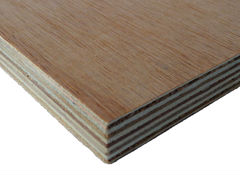 Plywood Trailer Decking
Plywood Trailer Decking
Plywood decking is by far the most common decking material used due to its high strength to weight ratio, its low cost and because it is quick and easy to fit (and replace if required).
Construction plywood is one of the best grades of ply for trailer decks as it is fully bonded with exterior glues and pressure treated to prevent rot and decay. It does pay to check with the supplier regarding the treatment and glue used, especially if the plywood is abnormally cheap as there are some inferior and substandard imported plywood. Another thing to check is the thickness of the top veneer. Some manufacturers sand the top face so much that the veneer is only paper thin. Within a few months this thin veneer can split, de-laminate and deteriorate to the point where the deck is unsightly and the deck surface is increasingly difficult to work with. The top veneer needs to be as thick as possible to ensure the deck surface stays in the best usable condition for as long as possible.
Plywood comes in various grades depending on their end use and will normally have one good face and one of varying quality. It is the good face you need to worry about and you shouldn’t concern yourself too much with the back face unless it is of very poor quality.
Marine grade ply is the ultimate grade for decking plywood and you will have to have a very large wallet or an exceptional need to warrant using this on your trailer.
Plywood comes in the following grades –
A Grade – This is a high quality appearance face for clear finishing and decorative purposes. Marine plywood is only available with an A face on both sides (A-A)
B Grade – This is a relatively high grade face which is suitable for a high quality painted finish. Very minor splits or cracks will be filled with exterior grade putty.
C Grade – a non-appearance grade with small splits and small tight knots and holes which may be filled with exterior grade putty if required.
D Grade – a non-appearance grade which face is un-sanded and with open defects.
A “B” or “C” face is suitable for the trailer deck top face with either “C” or “D” for the back face.
For a standard general purpose deck, plywood thickness of 3/4" is more than suitable. If you are transporting large animals or heavy, high point loading items, 1" would be recommended. To improve slip resistance, particularly for animals, concrete reinforcing mesh or chicken mesh can be stapled or screwed to the deck.
As with all treated timber, hot dipped galvanized screws or nails (see timber decking above) are the preferred choice for fastening the deck to the chassis. Plain steel or zinc coated/plated fastenings should never be used due to the corrosive nature of the chemicals used in treating the plywood.
Sealing the deck including edges, with an oil based sealer/stain is recommended before fitting to the trailer to give the deck its best chance of a long and useful life.